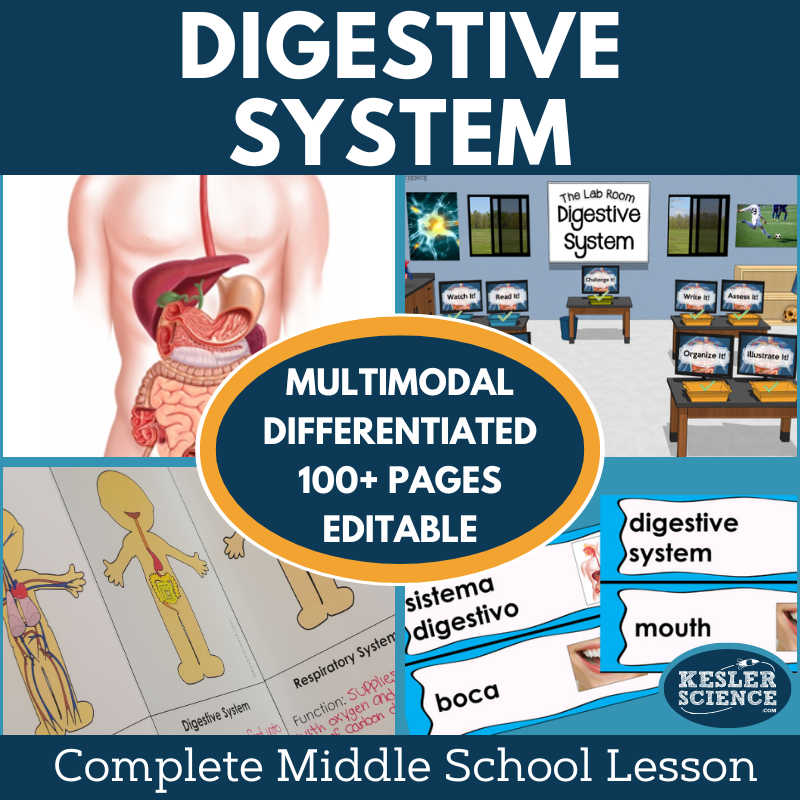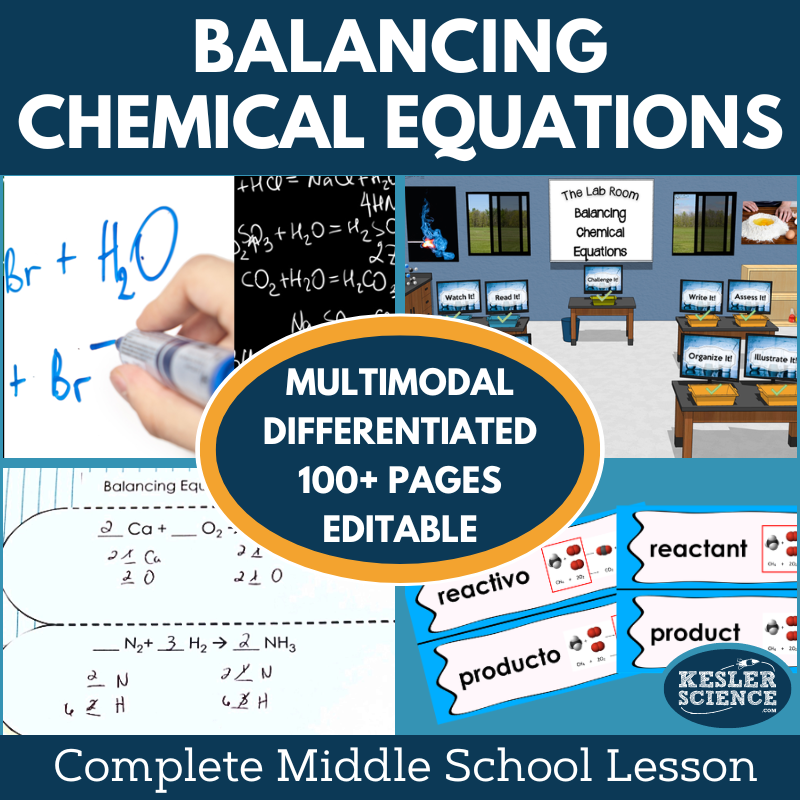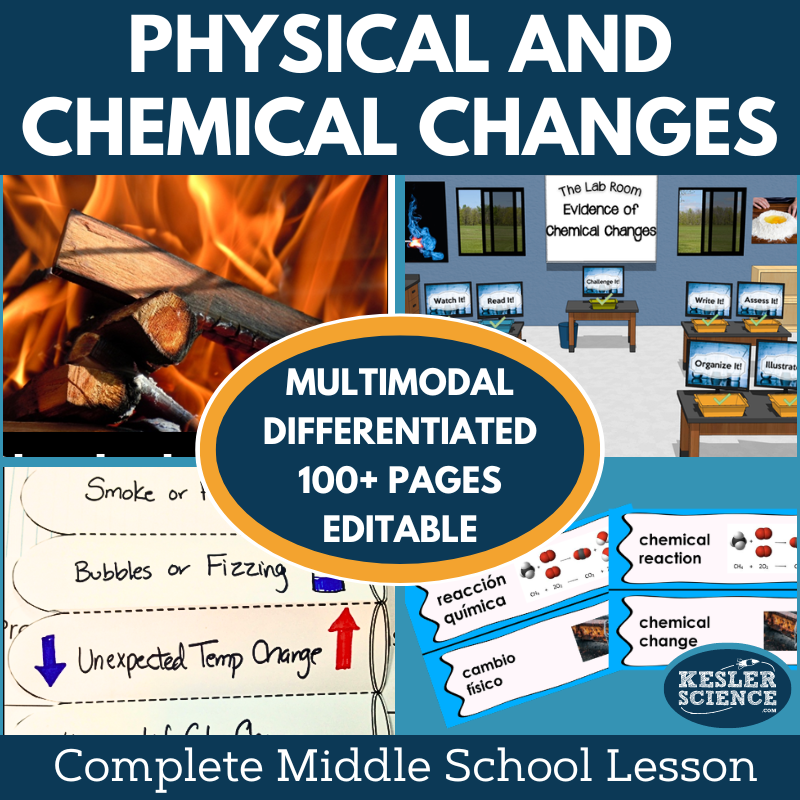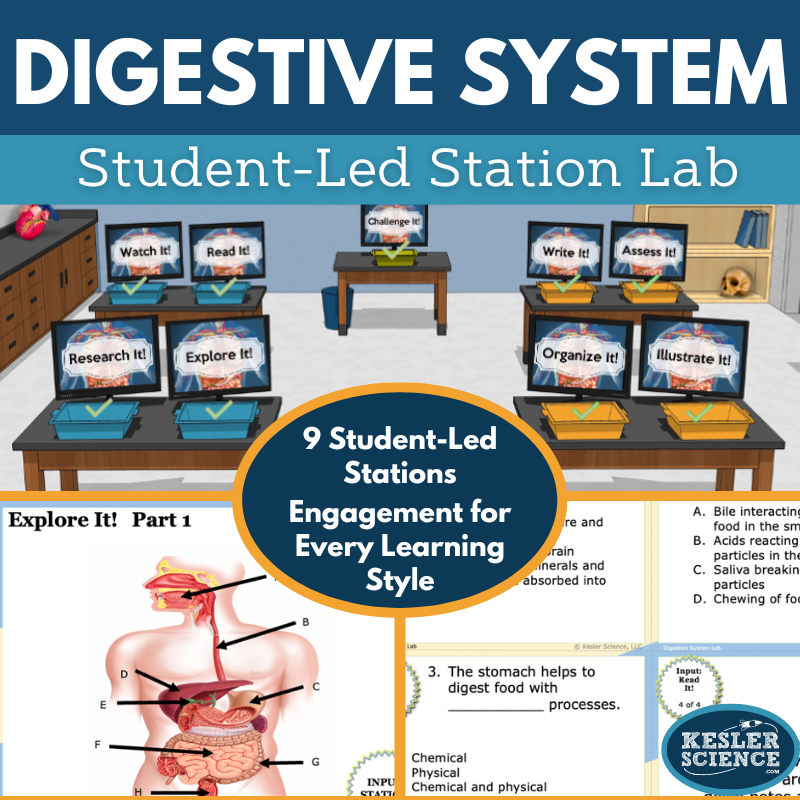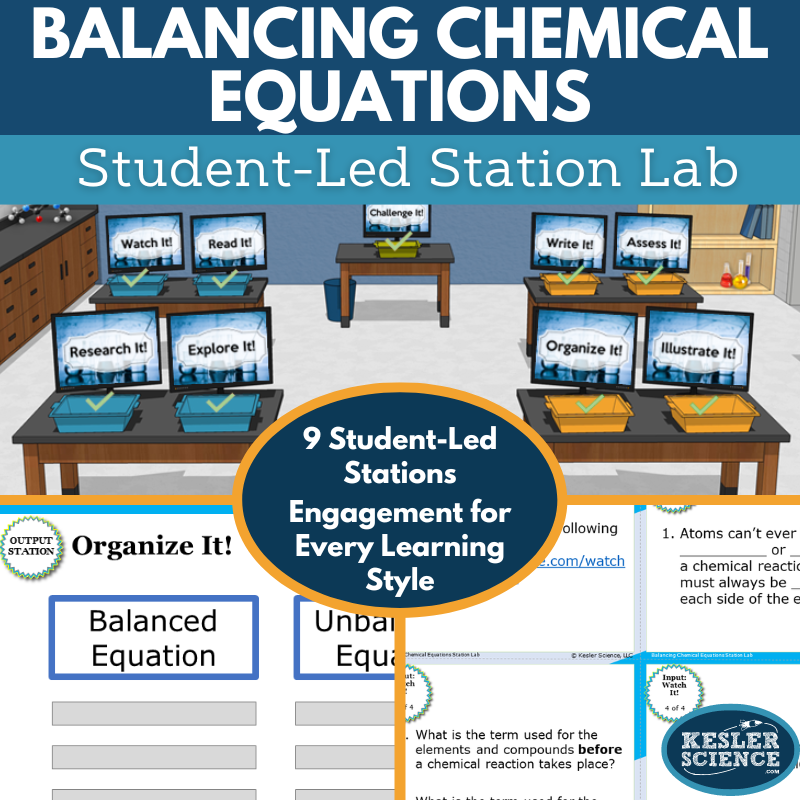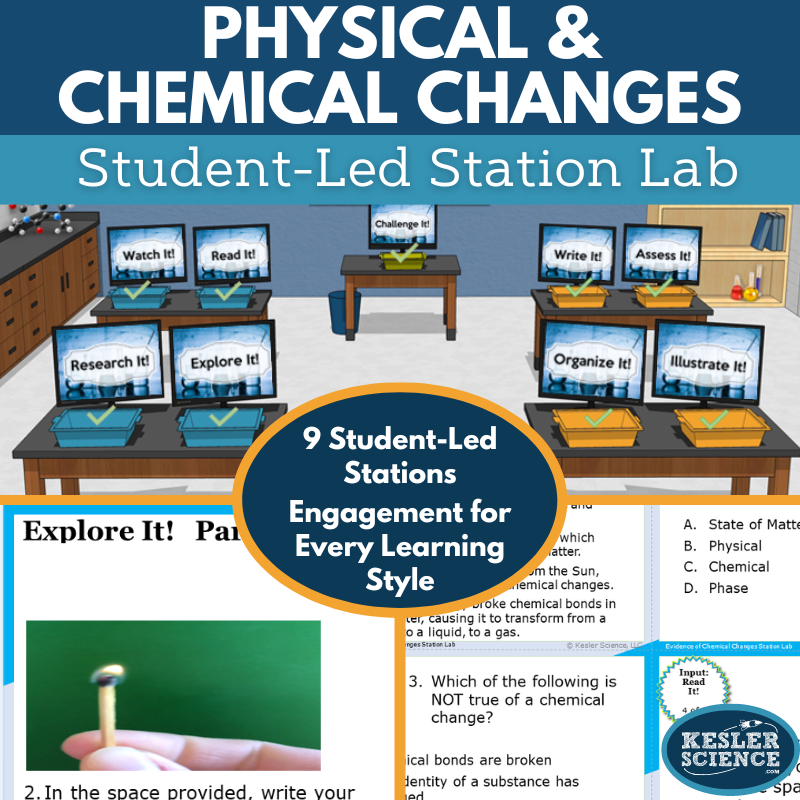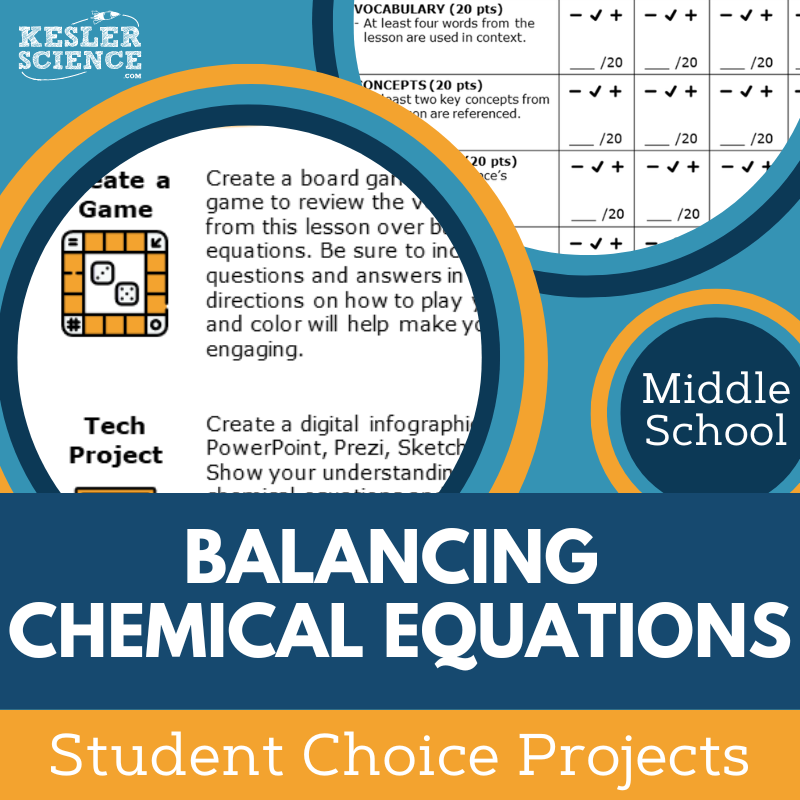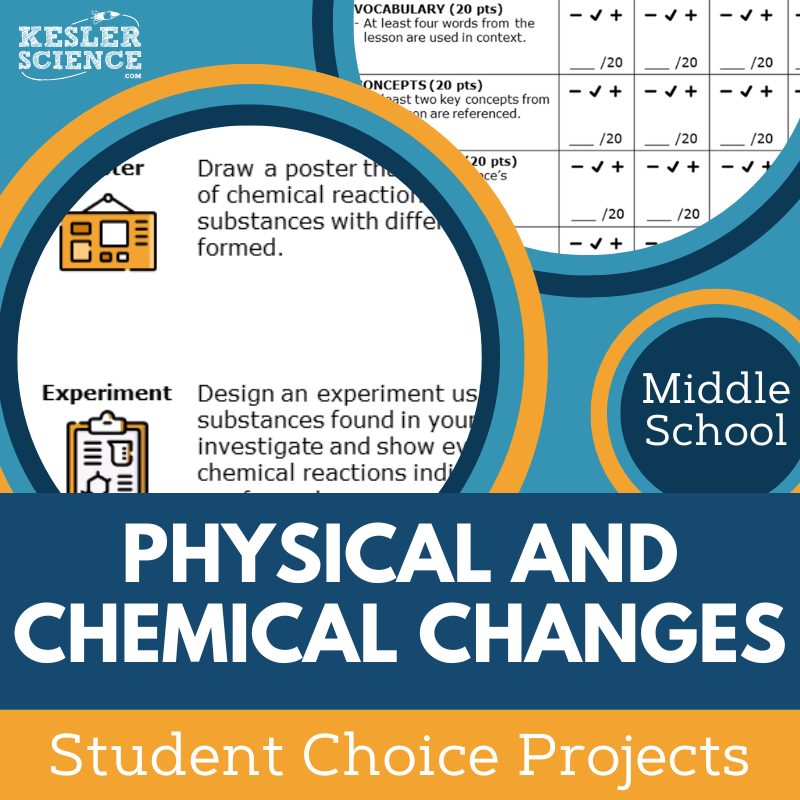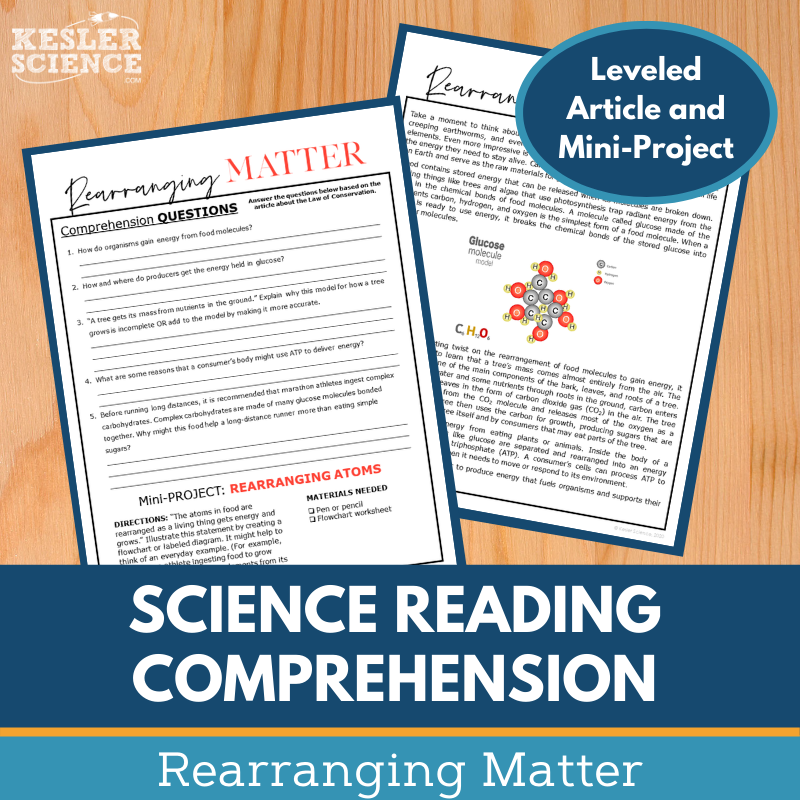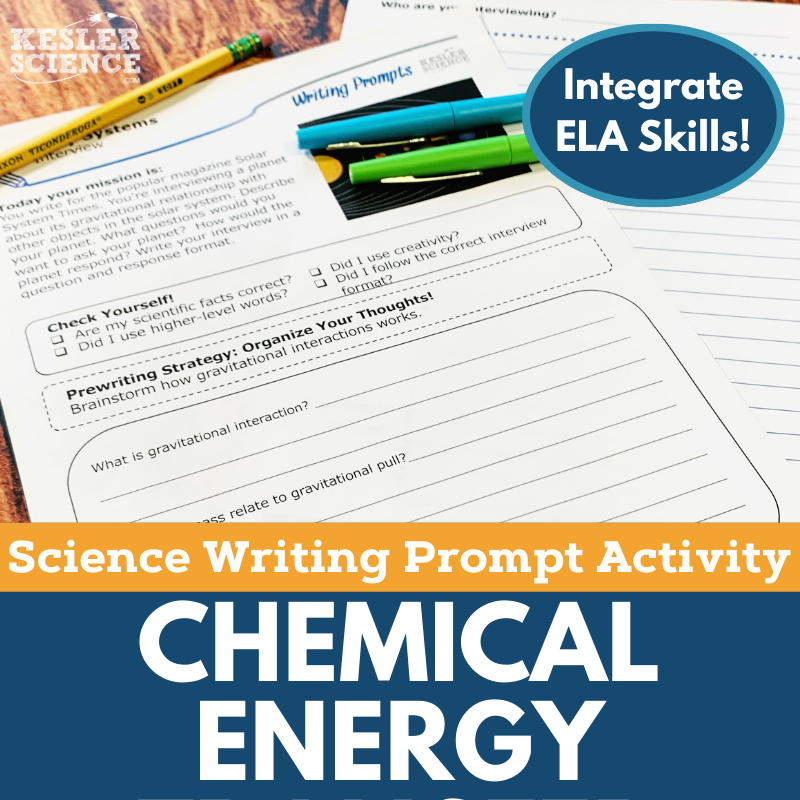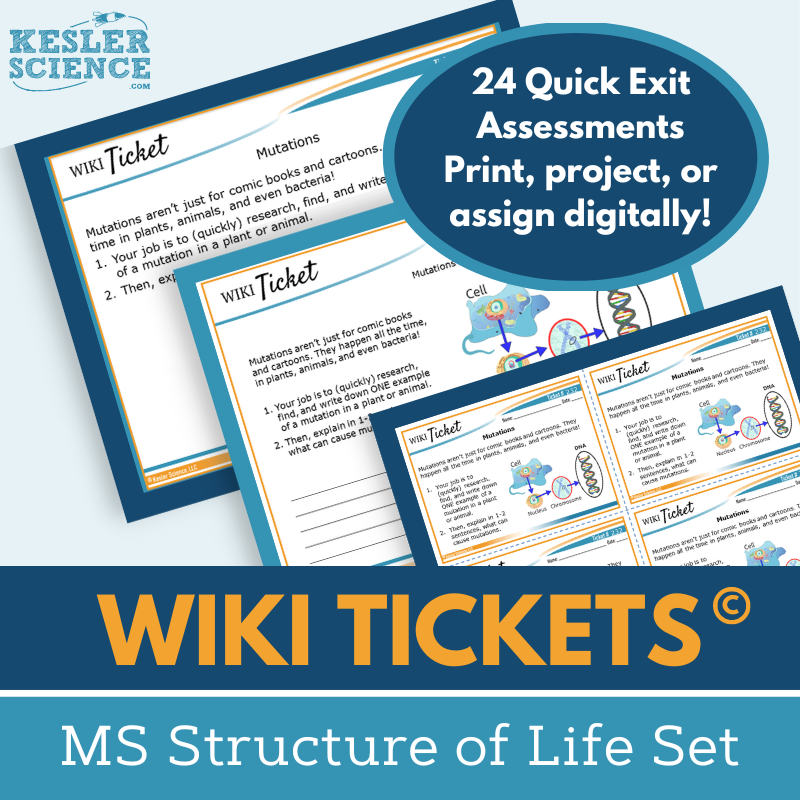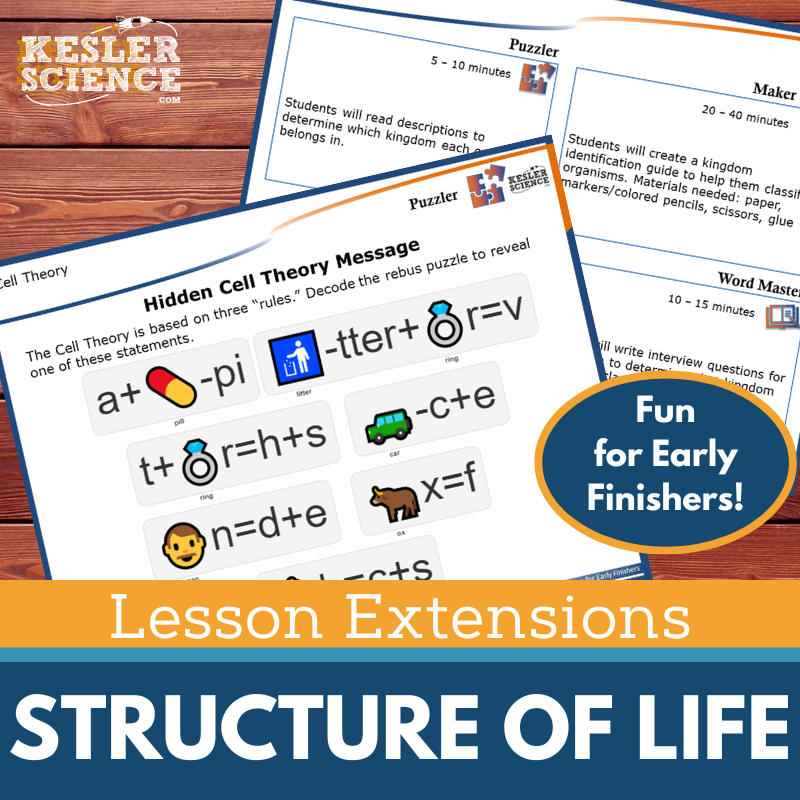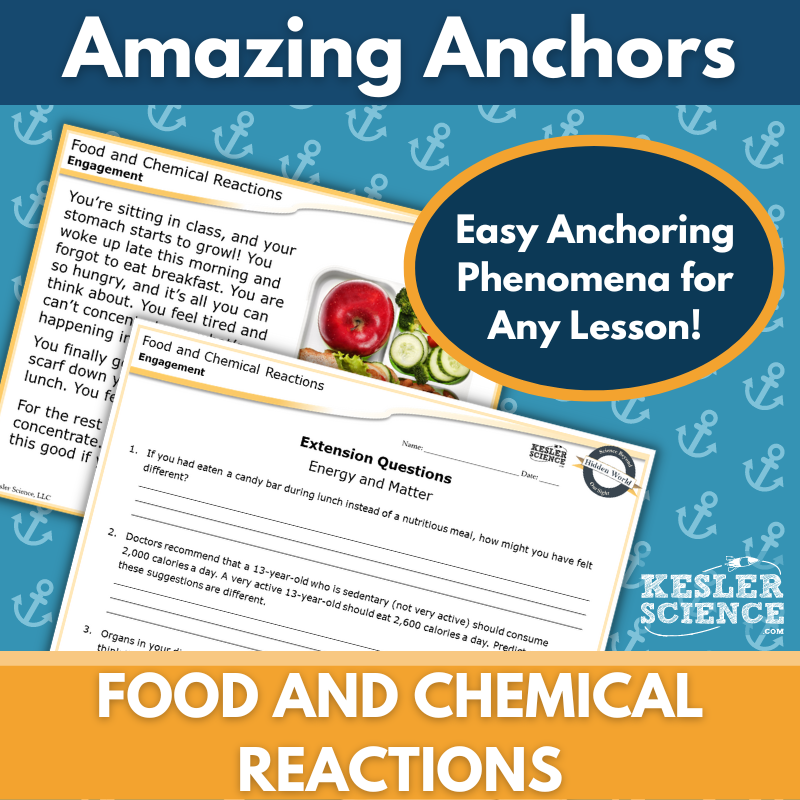Food & Chemical Reactions Activities for Middle School Science
The Kesler Science lessons on the digestive system, balancing equations, and physical and chemical reactions provides a comprehensive, editable middle school lesson with presentations, worksheets, choice projects, and assessments. The resources below will give students a comprehensive understanding of food and chemical reactions. All of the following materials are also included in the Kesler Science Membership.
The Kesler Science Digestive System unit is a comprehensive, editable middle school lesson with presentations, worksheets, choice projects, and assessments. It follows the 5E Model, focusing on engagement, exploration, explanation, elaboration, and evaluation to facilitate student-led, differentiated learning. The unit includes multimodal activities such as station labs, where students engage with the material through reading, videos, hands-on demos, and research. Output stations allow students to show understanding through writing, categorizing, and drawing.
The lesson covers essential questions about the digestive system's structure and function, with differentiated materials and Spanish translations for accessibility. Editable PowerPoints and interactive notebooks, available in both digital and print formats, cater to different learning styles. The unit also includes student-choice projects for deeper exploration and assessments aligned with STAAR 2.0. Designed for both classroom and virtual settings, this unit requires minimal prep while offering maximum flexibility for teachers.
The Kesler Science Digestive System unit is a comprehensive, editable middle school lesson with presentations, worksheets, choice projects, and assessments. It follows the 5E Model, focusing on engagement, exploration, explanation, elaboration, and evaluation to facilitate student-led, differentiated learning. The unit includes multimodal activities such as station labs, where students engage with the material through reading, videos, hands-on demos, and research. Output stations allow students to show understanding through writing, categorizing, and drawing.
The lesson covers essential questions about the digestive system's structure and function, with differentiated materials and Spanish translations for accessibility. Editable PowerPoints and interactive notebooks, available in both digital and print formats, cater to different learning styles. The unit also includes student-choice projects for deeper exploration and assessments aligned with STAAR 2.0. Designed for both classroom and virtual settings, this unit requires minimal prep while offering maximum flexibility for teachers.
The Kesler Science Balancing Chemical Equations 5E Lesson is designed for engaging middle school students in learning how to balance chemical equations. It includes editable PowerPoints, worksheets, choice projects, assessments, and student-led activities with minimal prep required. The lesson is aligned to TEKS and NGSS standards.
Students will explore essential questions such as the parts of a chemical equation, how to determine if an equation is balanced, and how this relates to the law of conservation of mass. The lesson features differentiated materials and multimodal learning for various learning styles. The station lab introduces nine stations, including hands-on demos, reading passages, research tasks, and video discussions. Students will organize, write, illustrate, and assess their understanding at different output stations, with additional challenge activities for early finishers.
The lesson includes editable PowerPoints, interactive notebooks in English and Spanish, and templates for note-taking. It also offers student-choice projects, updated STAAR 2.0 assessments, and review questions for class discussions. The lesson is flexible for both in-person and virtual learning environments.
The Kesler Science Balancing Chemical Equations 5E Lesson is designed for engaging middle school students in learning how to balance chemical equations. It includes editable PowerPoints, worksheets, choice projects, assessments, and student-led activities with minimal prep required. The lesson is aligned to TEKS and NGSS standards.
Students will explore essential questions such as the parts of a chemical equation, how to determine if an equation is balanced, and how this relates to the law of conservation of mass. The lesson features differentiated materials and multimodal learning for various learning styles. The station lab introduces nine stations, including hands-on demos, reading passages, research tasks, and video discussions. Students will organize, write, illustrate, and assess their understanding at different output stations, with additional challenge activities for early finishers.
The lesson includes editable PowerPoints, interactive notebooks in English and Spanish, and templates for note-taking. It also offers student-choice projects, updated STAAR 2.0 assessments, and review questions for class discussions. The lesson is flexible for both in-person and virtual learning environments.
The Kesler Science Physical and Chemical Changes 5E Lesson is designed for middle school students to explore how evidence of chemical reactions shows that new substances with different properties are formed. It includes editable presentations, worksheets, choice projects, and assessments, offering maximum flexibility for classroom or virtual use. This student-led, differentiated lesson follows the 5E Model: Engagement, Exploration, Explanation, Elaboration, and Evaluation.
Students engage with vocabulary and class activities, followed by a student-led station lab with nine stations. The stations allow students to explore physical and chemical changes in different ways, such as through hands-on demos, readings, research, and videos. Output stations help students demonstrate their learning through card sorts, writing, and illustrations, with bonus challenges for early finishers.
The lesson also includes editable PowerPoints, interactive notebook templates, and student-choice projects to extend learning. Evaluation tools include STAAR 2.0 aligned assessment questions and review materials. With options for both in-person and virtual environments, this comprehensive lesson meets diverse learning needs.
The Kesler Science Physical and Chemical Changes 5E Lesson is designed for middle school students to explore how evidence of chemical reactions shows that new substances with different properties are formed. It includes editable presentations, worksheets, choice projects, and assessments, offering maximum flexibility for classroom or virtual use. This student-led, differentiated lesson follows the 5E Model: Engagement, Exploration, Explanation, Elaboration, and Evaluation.
Students engage with vocabulary and class activities, followed by a student-led station lab with nine stations. The stations allow students to explore physical and chemical changes in different ways, such as through hands-on demos, readings, research, and videos. Output stations help students demonstrate their learning through card sorts, writing, and illustrations, with bonus challenges for early finishers.
The lesson also includes editable PowerPoints, interactive notebook templates, and student-choice projects to extend learning. Evaluation tools include STAAR 2.0 aligned assessment questions and review materials. With options for both in-person and virtual environments, this comprehensive lesson meets diverse learning needs.
This student-led station lab on the digestive system engages middle school students by guiding them through interactive activities to explore the function of the digestive system and its organs. Designed to be both comprehensive and easy to implement, the lab provides a variety of learning experiences that allow students to take ownership of their learning. The teacher's role is to facilitate rather than direct, promoting student independence in understanding key concepts.
The lab consists of nine stations, each offering differentiated tasks that cater to various learning styles and levels. Students can engage with the material through hands-on demonstrations, reading passages, video analysis, and research activities. The stations also include tasks where students organize, illustrate, and write about what they have learned, reinforcing their understanding through multiple forms of output. A bonus challenge station is available for advanced students, offering extension activities to deepen their learning.
This station lab is adaptable for both in-person and virtual learning environments, with digital versions of the tasks available through platforms like PowerPoint and Google Slides. Whether in the classroom or online, this activity supports personalized, student-centered learning, making it a flexible and effective resource for teaching the digestive system.
This student-led station lab on the digestive system engages middle school students by guiding them through interactive activities to explore the function of the digestive system and its organs. Designed to be both comprehensive and easy to implement, the lab provides a variety of learning experiences that allow students to take ownership of their learning. The teacher's role is to facilitate rather than direct, promoting student independence in understanding key concepts.
The lab consists of nine stations, each offering differentiated tasks that cater to various learning styles and levels. Students can engage with the material through hands-on demonstrations, reading passages, video analysis, and research activities. The stations also include tasks where students organize, illustrate, and write about what they have learned, reinforcing their understanding through multiple forms of output. A bonus challenge station is available for advanced students, offering extension activities to deepen their learning.
This station lab is adaptable for both in-person and virtual learning environments, with digital versions of the tasks available through platforms like PowerPoint and Google Slides. Whether in the classroom or online, this activity supports personalized, student-centered learning, making it a flexible and effective resource for teaching the digestive system.
This student-led activity on balancing chemical equations is designed to keep middle school students engaged and promote independent learning. Through eight differentiated stations and a ninth challenge station for early finishers, students explore key concepts related to the law of conservation and balancing chemical equations. The stations are modular and can be done independently or in small groups, with minimal preparation required by the teacher, allowing for a more student-centered learning experience.
The stations offer a variety of input and output activities to engage different learning styles. Input stations include "Explore It!", where students apply information through images and text, "Research It!", which uses a website for deeper learning, "Read It!" for differentiated reading passages, and "Watch It!" where students view a video and answer questions. Output stations provide hands-on activities like "Organize It!" with manipulatives, visual representation in "Illustrate It!", written responses in "Write It!", and assessment using task cards in "Assess It!". The "Challenge It!" station offers extension activities for advanced learners.
This flexible station lab can be used both in the classroom and virtually. With all necessary resources and task cards provided, students are able to take ownership of their learning, allowing them to master the concepts of balancing chemical equations at their own pace.
This student-led activity on balancing chemical equations is designed to keep middle school students engaged and promote independent learning. Through eight differentiated stations and a ninth challenge station for early finishers, students explore key concepts related to the law of conservation and balancing chemical equations. The stations are modular and can be done independently or in small groups, with minimal preparation required by the teacher, allowing for a more student-centered learning experience.
The stations offer a variety of input and output activities to engage different learning styles. Input stations include "Explore It!", where students apply information through images and text, "Research It!", which uses a website for deeper learning, "Read It!" for differentiated reading passages, and "Watch It!" where students view a video and answer questions. Output stations provide hands-on activities like "Organize It!" with manipulatives, visual representation in "Illustrate It!", written responses in "Write It!", and assessment using task cards in "Assess It!". The "Challenge It!" station offers extension activities for advanced learners.
This flexible station lab can be used both in the classroom and virtually. With all necessary resources and task cards provided, students are able to take ownership of their learning, allowing them to master the concepts of balancing chemical equations at their own pace.
This student-led activity on physical and chemical changes engages middle school students with nine modular stations, offering differentiated, hands-on tasks. Students learn to identify chemical changes through activities like reading, researching, watching videos, and performing hands-on experiments. The stations include “Explore It!” for hands-on demonstrations, “Research It!” with a website-based learning task, “Read It!” with differentiated reading passages, and “Watch It!” with a video and related questions.
Output stations focus on students showing their understanding by organizing information, illustrating models, writing responses, and assessing their learning with task cards. A bonus challenge station provides extension activities for early finishers. This modular, student-centered approach promotes independent learning, with the option for virtual adaptation, making it flexible for both in-class and online learning.
This student-led activity on physical and chemical changes engages middle school students with nine modular stations, offering differentiated, hands-on tasks. Students learn to identify chemical changes through activities like reading, researching, watching videos, and performing hands-on experiments. The stations include “Explore It!” for hands-on demonstrations, “Research It!” with a website-based learning task, “Read It!” with differentiated reading passages, and “Watch It!” with a video and related questions.
Output stations focus on students showing their understanding by organizing information, illustrating models, writing responses, and assessing their learning with task cards. A bonus challenge station provides extension activities for early finishers. This modular, student-centered approach promotes independent learning, with the option for virtual adaptation, making it flexible for both in-class and online learning.
The Digestive System Student Choice Projects allow middle school students to select a project that matches their preferred output style. The project page features six student-led options and a “design your own” project. An editable grading rubric is available for teacher, peer, or self-assessment, and can be adjusted to meet specific grading needs. The projects offer multimodal choices, enabling students to creatively demonstrate their understanding.
Differentiated for various needs, the project page includes two versions: one with modified options to support students needing remediation and another that challenges advanced learners while using the same rubric. The projects require standard classroom supplies like paper, markers, and scissors, with many options available for digital completion.
The Digestive System Student Choice Projects allow middle school students to select a project that matches their preferred output style. The project page features six student-led options and a “design your own” project. An editable grading rubric is available for teacher, peer, or self-assessment, and can be adjusted to meet specific grading needs. The projects offer multimodal choices, enabling students to creatively demonstrate their understanding.
Differentiated for various needs, the project page includes two versions: one with modified options to support students needing remediation and another that challenges advanced learners while using the same rubric. The projects require standard classroom supplies like paper, markers, and scissors, with many options available for digital completion.
The Balancing Chemical Equations Student Choice Projects lesson allows middle school students to select a project that matches their preferred output style. The project page outlines six options plus a "design your own" project. An editable grading rubric supports assessments by teachers, peers, or students themselves.
These flexible projects offer creative ways for students to demonstrate their understanding. Teachers can adjust the rubric to fit grading needs, and the projects are designed for both hands-on and digital completion using standard classroom supplies like paper, markers, and scissors. For students needing remediation, three project options are available, while advanced learners can combine projects for a challenge.
The project also includes teacher directions and editable rubric pages that assess vocabulary, concepts, presentation, clarity, and accuracy.
The Balancing Chemical Equations Student Choice Projects lesson allows middle school students to select a project that matches their preferred output style. The project page outlines six options plus a "design your own" project. An editable grading rubric supports assessments by teachers, peers, or students themselves.
These flexible projects offer creative ways for students to demonstrate their understanding. Teachers can adjust the rubric to fit grading needs, and the projects are designed for both hands-on and digital completion using standard classroom supplies like paper, markers, and scissors. For students needing remediation, three project options are available, while advanced learners can combine projects for a challenge.
The project also includes teacher directions and editable rubric pages that assess vocabulary, concepts, presentation, clarity, and accuracy.
The Physical and Chemical Changes Student Choice Projects lesson provides middle school students with a variety of project options, allowing them to choose an approach that aligns with their preferred output style. The project page includes six different student-led options, along with the opportunity to design a custom project. A grading rubric is included for assessment by teachers, peers, or students, and teachers can adjust the rubric to fit specific grading needs. The flexible nature of these projects supports creativity and personal expression, offering multiple ways for students to demonstrate their understanding.
This lesson is designed to be adaptable for a wide range of student needs, with modified options available for those requiring remediation and advanced challenges for students seeking a more rigorous experience. The projects rely on standard classroom supplies such as paper, markers, and scissors, and many can be completed digitally. This flexibility allows teachers to cater to diverse learning styles while maintaining clear expectations for assessment and presentation.
The Physical and Chemical Changes Student Choice Projects lesson provides middle school students with a variety of project options, allowing them to choose an approach that aligns with their preferred output style. The project page includes six different student-led options, along with the opportunity to design a custom project. A grading rubric is included for assessment by teachers, peers, or students, and teachers can adjust the rubric to fit specific grading needs. The flexible nature of these projects supports creativity and personal expression, offering multiple ways for students to demonstrate their understanding.
This lesson is designed to be adaptable for a wide range of student needs, with modified options available for those requiring remediation and advanced challenges for students seeking a more rigorous experience. The projects rely on standard classroom supplies such as paper, markers, and scissors, and many can be completed digitally. This flexibility allows teachers to cater to diverse learning styles while maintaining clear expectations for assessment and presentation.
This lab aligns with NGSS MS LS1-7, where students develop a model to describe how food undergoes chemical reactions in the body to release energy and support growth. Students create a 2D model of a meal to show the chemical reactions in the human body. The lab is available in both digital and print formats, with comprehension questions, Claim-Evidence-Reasoning (C.E.R.) prompts, and a reflection section included.
The lab includes three differentiated versions for various skill levels: Dependent, Modified, and Independent, each offering varying degrees of support and structure to cater to different learners. The print version requires basic supplies like scissors, glue, and colored pencils, while the digital format offers a fully interactive experience with no materials required.
The digital format is compatible with Google Slides and can be shared via platforms like MS Teams and Canvas. Teacher resources, answer keys, and editable files are included to enhance planning and flexibility.
This lab aligns with NGSS MS LS1-7, where students develop a model to describe how food undergoes chemical reactions in the body to release energy and support growth. Students create a 2D model of a meal to show the chemical reactions in the human body. The lab is available in both digital and print formats, with comprehension questions, Claim-Evidence-Reasoning (C.E.R.) prompts, and a reflection section included.
The lab includes three differentiated versions for various skill levels: Dependent, Modified, and Independent, each offering varying degrees of support and structure to cater to different learners. The print version requires basic supplies like scissors, glue, and colored pencils, while the digital format offers a fully interactive experience with no materials required.
The digital format is compatible with Google Slides and can be shared via platforms like MS Teams and Canvas. Teacher resources, answer keys, and editable files are included to enhance planning and flexibility.
In this lesson, students explore how food is rearranged through chemical reactions to form new molecules that support growth or release energy. They read a nonfiction article on matter rearrangement and complete comprehension questions. Students then research and create a flowchart or labeled diagram illustrating an example of this process.
The resource is designed for middle school students, offering a leveled science passage to enhance reading comprehension and science literacy. It includes 5-7 comprehension questions, a hands-on mini-project, and a Cornell notes template. The passage is suitable for both in-person and virtual learning, with files compatible with platforms like Google Classroom, MS Teams, Schoology, and Canvas.
This passage is ideal for absent students, extra credit, sub plans, or whole-class instruction, and encourages engaging classroom discussions while building textual analysis and reading comprehension skills.
In this lesson, students explore how food is rearranged through chemical reactions to form new molecules that support growth or release energy. They read a nonfiction article on matter rearrangement and complete comprehension questions. Students then research and create a flowchart or labeled diagram illustrating an example of this process.
The resource is designed for middle school students, offering a leveled science passage to enhance reading comprehension and science literacy. It includes 5-7 comprehension questions, a hands-on mini-project, and a Cornell notes template. The passage is suitable for both in-person and virtual learning, with files compatible with platforms like Google Classroom, MS Teams, Schoology, and Canvas.
This passage is ideal for absent students, extra credit, sub plans, or whole-class instruction, and encourages engaging classroom discussions while building textual analysis and reading comprehension skills.
The Chemical Energy Science Writing Prompt Activity helps middle school students test their knowledge of life science by using an invention-based approach to create engaging exercises. It promotes science reasoning and exploration, allowing students to enrich their writing in both classroom and virtual settings.
Aligned with the MS LS1-7 standard, students develop a model to describe how food is rearranged through chemical reactions, forming new molecules that support growth and release energy as it moves through an organism.
This activity includes teacher directions, a projection version for sharing digitally, full-sized handouts with prompts, self-checks, and pre-writing strategies, and half-sheet handouts that fit into interactive notebooks. There is also a digital interactive version compatible with Google Slides for both in-person and remote learning.
This prompt works well as a cross-curricular activity, pre-test assessment, student project, or elaboration for early finishers. It's ideal for extra credit, make-up work, TELPAS samples, and differentiation exercises. These prompts are great for bulletin board displays or student anthologies.
The Chemical Energy Science Writing Prompt Activity helps middle school students test their knowledge of life science by using an invention-based approach to create engaging exercises. It promotes science reasoning and exploration, allowing students to enrich their writing in both classroom and virtual settings.
Aligned with the MS LS1-7 standard, students develop a model to describe how food is rearranged through chemical reactions, forming new molecules that support growth and release energy as it moves through an organism.
This activity includes teacher directions, a projection version for sharing digitally, full-sized handouts with prompts, self-checks, and pre-writing strategies, and half-sheet handouts that fit into interactive notebooks. There is also a digital interactive version compatible with Google Slides for both in-person and remote learning.
This prompt works well as a cross-curricular activity, pre-test assessment, student project, or elaboration for early finishers. It's ideal for extra credit, make-up work, TELPAS samples, and differentiation exercises. These prompts are great for bulletin board displays or student anthologies.
These formative assessments for 6th-8th grade science offer flexible options to check student understanding in a fun, engaging format. The Structure of Life Set includes 24 WIKI Tickets©, each with five formats: a full-screen display for projection, three handout sizes (full, split, and quarter-page), and an interactive version that can be assigned digitally as an editable PowerPoint or Google Slides file.
Aligned with NGSS and TEKS standards, some topics have multiple tickets, while all standards are covered. A bonus table of contents file is included for easy reference. These assessments are designed for both in-person and virtual learning environments, making them versatile for any classroom setting.
Topics in this set cover areas such as reproduction, cell function, heredity, mutations, homeostasis, and genetic factors, among others. WIKI Tickets© can be used as exit tickets, bellringers, or quick assessments in any learning environment, whether on campus or remote, with students answering on their own device or paper.
These formative assessments for 6th-8th grade science offer flexible options to check student understanding in a fun, engaging format. The Structure of Life Set includes 24 WIKI Tickets©, each with five formats: a full-screen display for projection, three handout sizes (full, split, and quarter-page), and an interactive version that can be assigned digitally as an editable PowerPoint or Google Slides file.
Aligned with NGSS and TEKS standards, some topics have multiple tickets, while all standards are covered. A bonus table of contents file is included for easy reference. These assessments are designed for both in-person and virtual learning environments, making them versatile for any classroom setting.
Topics in this set cover areas such as reproduction, cell function, heredity, mutations, homeostasis, and genetic factors, among others. WIKI Tickets© can be used as exit tickets, bellringers, or quick assessments in any learning environment, whether on campus or remote, with students answering on their own device or paper.
Lesson Extensions provide student-choice activities to challenge fast finishers with critical thinking and creativity. These engaging activities are perfect for lesson wrap-ups, filling downtime during testing, and preventing distractions while offering rigorous yet fun learning opportunities. The extensions help scaffold learning for students ready to explore deeper concepts related to life science standards.
Each extension includes four activities: Puzzler to improve problem-solving, Maker Space for hands-on STEAM activities, Tech Connection for digital demonstrations, and Word Master to incorporate creative writing. These come with teacher directions, answer keys, and both print and projection versions for easy use.
The extensions are ideal for pushing independent learners further, offering interactive, hands-on engagement and creativity, making them a great way to enhance life science lessons. Topics covered include artificial selection, body systems, cell theory, heredity, natural selection, and more, all aligned with NGSS and TEKS science standards.
These Extensions provide student-choice activities to challenge fast finishers with critical thinking and creativity. These engaging activities are perfect for lesson wrap-ups, filling downtime during testing, and preventing distractions while offering rigorous yet fun learning opportunities. The extensions help scaffold learning for students ready to explore deeper concepts related to life science standards.
Each extension includes four activities: Puzzler to improve problem-solving, Maker Space for hands-on STEAM activities, Tech Connection for digital demonstrations, and Word Master to incorporate creative writing. These come with teacher directions, answer keys, and both print and projection versions for easy use.
The extensions are ideal for pushing independent learners further, offering interactive, hands-on engagement and creativity, making them a great way to enhance life science lessons. Topics covered include artificial selection, body systems, cell theory, heredity, natural selection, and more, all aligned with NGSS and TEKS science standards.
This NGSS-aligned, no-prep Amazing Anchors lesson introduces and reinforces chemical reactions through an engaging phenomenon. The two-part resource includes an introductory reading about skipping breakfast, with comprehension and extension questions to prepare students for further learning. The second reading explains the science behind energy release in chemical reactions, with additional questions to reinforce understanding.
The lesson includes teacher directions, answer keys, full-page projection slides, digital editable PPTs for LMS, and paper handouts for INBs. Aligned with NGSS standard LS1-7, this lesson is ideal for the Engagement and Elaborate stages of 5E lessons. Differentiated versions are available, with one offering sentence starters to assist students. The lesson is available in both print and digital formats for easy integration into any classroom setup.
This NGSS-aligned, no-prep Amazing Anchors lesson introduces and reinforces chemical reactions through an engaging phenomenon. The two-part resource includes an introductory reading about skipping breakfast, with comprehension and extension questions to prepare students for further learning. The second reading explains the science behind energy release in chemical reactions, with additional questions to reinforce understanding.
The lesson includes teacher directions, answer keys, full-page projection slides, digital editable PPTs for LMS, and paper handouts for INBs. Aligned with NGSS standard LS1-7, this lesson is ideal for the Engagement and Elaborate stages of 5E lessons. Differentiated versions are available, with one offering sentence starters to assist students. The lesson is available in both print and digital formats for easy integration into any classroom setup.
Year-Round Resources
These year-round activities will increase your students' understanding of many middle school science topics. All of these activities are also included in the Kesler Science Membership.
Visual Data & Graphing
You're not alone if your students struggle with understanding graphs, charts, and tables. It's a skill that takes an enormous amount of practice. This resource will help students build a strong foundation in analyzing data and creating their own data visualizations.
Bell Ringers and Warm-Ups
These middle school science bell ringers are an excellent way to engage your students as soon as they walk into your classroom. This comprehensive FULL YEAR resource includes everything you need to start off each science class with an interesting warm-up activity.
Review Board Games
Each game board has been carefully designed to keep students engaged. There are 10 different action spaces on each board and dozens of question cards. All of the actions are related to science concepts and keep the students motivated throughout the game.
Each game is ready to play. Simply print out the board and the cards and let the students enjoy reviewing nine different units.
Essential Questions and Standards
Below are the essential questions and standards associated with the lessons and activities included in the food & chemical reactions unit. This topic is only one of more than 100 middle school science topics included in the Kesler Science Membership.
-
What is the main function of the digestive system and how is it structured?
-
What are the main organs associated with this system?
-
What are the different parts of the chemical equation?
-
How can we tell if a chemical equation is balanced or not?
-
How does balancing equations relate to the law of conservation of mass?
-
How does evidence of chemical reactions indicate that new substances with different properties are formed?
-
NGSS - MS-LS1-7 Food & Chemical Reactions
Kesler Science Membership
Imagine never having to search for another middle school science lesson again. The membership gives you access to ALL of the Kesler Science products in one place (Yes, including everything above).
Say goodbye to long hours of lesson prep.

